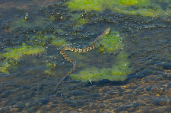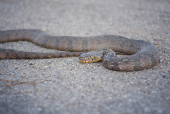Northern Diamondback Water Snake (N.r. rhombifer)
Description: It is predominantly brown, dark brown, or dark olive green in color, with a black net-like pattern along the back, with each spot being vaguely diamond-shaped. Dark vertical bars and lighter coloring are often present down the sides of the snake. In typical counter-colored fashion, the underside is generally a yellow or lighter brown color, often with black blotching.
The dorsal scales are heavily keeled, giving the snake a rough texture. The dorsal scales are arranged in 25 or 27 rows at midbody. There are usually 3 postoculars. Adult males have multiple papillae (tubercles) on the under surface of the chin, which are not found on any other species of snake in the United States. Average total length (including tail) of 30 to 48 inches. Neonates are often lighter in color, making their patterns more pronounced, and they darken with age.
Habitat: It is one of the most common species of snake within its range. It is found predominantly near slow-moving bodies of water such as streams, rivers, ponds, or swamps.
Range: The diamondback water snake is found in the central United States, predominantly along the Mississippi River valley, but its range extends beyond that. It ranges within the states of Texas, Oklahoma, Louisiana, Arkansas, Missouri, Mississippi, and Kentucky.
Diet: Northern diamond-backed watersnakes mostly eat fish and amphibians. Most of the fish they eat are small, slow moving, or dead. The amphibians they consume include adult and larval frogs, toads, and salamanders. They may also eat small snakes and turtles, earthworms, leeches, crayfish, and insects.
Reproduction: Like other Nerodia species, the Northern diamondback water snake is ovoviviparous. Adults breed in the spring, and gravid females give birth in the late summer or early fall. Neonates are around 8–10 inches in length. Though its range overlaps with several other species of water snakes, interbreeding is not known.
Status: Listed as Least Concern in view of its wide distribution, presumed large population, and because it is unlikely to be declining fast enough to qualify for listing in a more threatened category.
»» Kingdom: Animalia - Animals
»» Phylum: Chordata - Chordates
»» Subphylum: Vertebrata - Vertebrates
»» Class: Reptilia - Reptiles
»» Order: Squamata - Scaled Reptiles
»» Suborder: Serpentes
»» Superfamily: Colubroidea
»» Family: Colubridae - Colubrids
»» Genus: Nerodia
»» Species: Nerodia rhombifer - Diamondback Water Snake
»» Subspecies: N.r. rhombifer - Northern Diamondback Water Snake
This article uses material from the Wikipedia article "Nerodia rhombifer", which is released under the Creative Commons Attribution-Share-Alike License 3.0. Content may have been omitted from the original, but no content has been changed or extended.
|








